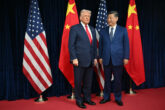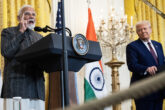August 04, 2021
Commercial satellites — not U.S. intelligence — revealed China’s missile program
Last week, researchers at the Federation of American Scientists used satellite imagery to uncover more than 100 suspected nuclear missile silos under construction in western China. Days later, private analysts identified new underground facilities at a Chinese nuclear test site using similar satellite images.
These revelations, coming after the discovery of another Chinese missile field in June, leveraged satellite imagery to disclose some of Beijing’s most closely guarded secrets about its nuclear program.
The proliferation of commercial satellites has upended this near-monopoly on government intelligence gathering.
But these images didn’t come from government intelligence agencies. Instead, they were collected using privately operated commercial satellites and analyzed at think tanks — no high-level security clearances required.
This is not how we used to find out about major national security secrets.
Once upon a time, such findings were almost exclusively in the hands of governments with robust intelligence organizations. The proliferation of commercial satellites has upended this near-monopoly on government intelligence gathering. And this also means leaders now have less freedom — both politically and strategically — to handle this kind of news.
Read the full article from The Washington Post.
More from CNAS
-
Indo-Pacific Security / Energy, Economics & Security
How to Win the Economic War with ChinaTrump's approach to China has run aground, giving Beijing unprecedented advantage in the economic conflict....
By Edward Fishman & Julian Gewirtz
-
America’s Self-Loathing Is a Losing Hand
This article was originally published in The Washington Post.Around 10 years ago, the United States began a historic shift in its grand strategy toward China, abandoning the b...
By David Feith
-
Indo-Pacific Security / Energy, Economics & Security / Technology & National Security
Selling AI Chips Won’t Keep China Hooked on U.S. TechnologyU.S. policy should not rest on the illusion that selling chips can trap China inside the American tech ecosystem....
By Janet Egan
-
Will New Delhi-Beijing Move Beyond Friction Points? | Ex-White Official On India-China Reset
Prime Minister Narendra Modi on Friday said that India and China, as two major economies, must work together to bring stability to the global economic order. NDTV's Gaurie Dwi...
By Lisa Curtis




